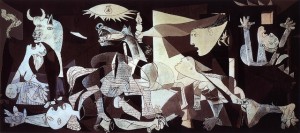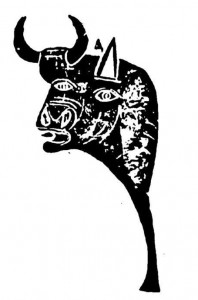On April 26th 1937, a massive air raid by the German Luftwaffe on the Basque town of Guernica in Northern Spain shocked the world. Hundreds of civilians were killed in the raid which became a major incident of the Spanish Civil War. Like so many such incidents in the history of warfare, this one could have faded from popular awareness had it not been for the astonishing work of art it inspired Pablo Picasso to create.
If you are ever in Madrid then a visit to the Reina Sofia to see Picasso’s Guernica is, unquestionably, a must. The Reina Sofia is a small gallery, developed from an 18th century hospital and is dedicated for the most part to Spanish art of the 20th century. Inside, the layout is relaxed and one of the themes of the gallery is history and how we interpret historical events, there could be no better home for Guernica to reside in. Size is, naturally, no benchmark for good or bad art (and yes, I have had people complain to me that they have seen larger posters than the original Mona Lisa) but there is a lot to be said for the first time you walk into the room and see Guernica, it is an incredible sensation. The canvas is 25 foot long and you immediately sense that this is a piece of art to work with, something that requires thought and exploration.
Incredibly, Picasso completed the work less than two months after the attack, it is presented in black, white and grey to give a sense of mourning.
The use of a newsprint effect is said to have been testimony to how Picasso himself learned of the attack. The images are stark, the symbolism seemingly obvious at first. However, there are numerous subtleties in the painting that make it worth more than one visit if you are lucky enough to get back to Madrid. The two most obvious features are a bull and a horse. Much has been made over the years of the symbolic role they play. When asked about them, Picasso gave the most wonderful reply, “this bull is a bull and this horse is a horse… If you give a meaning to certain things in my paintings it may be very true, but it is not my idea to give this meaning”. However, there is so much more to the picture than first meets the eye.
Recent studies have made much of the appearance of Harlequins in the work, representative to the artist as forces that could overcome the death that surrounded them. The center of the piece is where a number of images merge and the outline of a skull is found. Around the room in the museum you will find sketches that tell us just how much thought went into the creation of this astounding painting. When we recall it was completed in just two months, these sketches show the depth of motivation Picasso worked from. Once completed Guernica was sent on a world tour and Picasso was adamant that it should not return to Spain while Franco’s Nationalists remained in power, he stated that “the painting will be turned over to the government of the Spanish Republic the day the Republic is restored in Spain!”
Guernica has been the motivation for many peace projects and associated works across the world, there is a tapestry copy at the entrance to the Security Council room at the UN in New York. This recognition is truly well deserved, it is a masterpiece and it is a painting worthy of anyone’s time.
Flickr Photo via tiganatoo
Related articles


